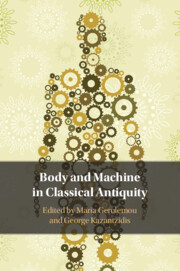Book contents
- Body and Machine in Classical Antiquity
- Body and Machine in Classical Antiquity
- Copyright page
- Contents
- Figures
- Contributors
- An Introduction to Body–Machine Intersections
- Part I Blended Bodies
- Part II The Technological Body
- Part III Towards the Mechanization of the Human Body
- Chapter 7 Aristotle on the Lung and the Bellows–Lungs Analogy
- Chapter 8 The Ill Effect of South Winds on the Joints in the Human Body
- Chapter 9 The Beauty That Lies Within
- Chapter 10 The Mechanics of the Heart in Antiquity
- Chapter 11 The Mechanics of Galen’s Theory of Nutrition
- Chapter 12 Iatromechanism and Antiquarianism in Morgagni’s Studies on Celsus, 1720–1761
- Conclusions or From Antiquity to the Early Modern
- Index of Passages
- General Index
- References
Chapter 9 - The Beauty That Lies Within
Anatomy, Mechanics and Thauma in Hellenistic Medicine
from Part III - Towards the Mechanization of the Human Body
Published online by Cambridge University Press: 13 July 2023
- Body and Machine in Classical Antiquity
- Body and Machine in Classical Antiquity
- Copyright page
- Contents
- Figures
- Contributors
- An Introduction to Body–Machine Intersections
- Part I Blended Bodies
- Part II The Technological Body
- Part III Towards the Mechanization of the Human Body
- Chapter 7 Aristotle on the Lung and the Bellows–Lungs Analogy
- Chapter 8 The Ill Effect of South Winds on the Joints in the Human Body
- Chapter 9 The Beauty That Lies Within
- Chapter 10 The Mechanics of the Heart in Antiquity
- Chapter 11 The Mechanics of Galen’s Theory of Nutrition
- Chapter 12 Iatromechanism and Antiquarianism in Morgagni’s Studies on Celsus, 1720–1761
- Conclusions or From Antiquity to the Early Modern
- Index of Passages
- General Index
- References
Summary
This chapter explores two scripts of thauma (marvel/wonder) regarding the interior of the human body: the first derives from the Aristotelian idea that a purpose can be assigned to virtually everything in the world, our interior organs included; as soon as the design within our bodies has been figured out, our interior instantly enters the realm of the beautiful. The second script of marvel pertains to the idea that there are little ‘machines’ and ‘sub-machines’ inside of us, with their own complex structures and their own distinctive power to make us marvel at their artistry and efficiency. Considerable attention has been paid recently on the reevaluation of the presumed polarity between teleology and mechanics in ancient Greek philosophy and medicine. Rather than assume a mutually exclusive relationship between the two, scholars argue that the two models can be seen as converging and combining with each other in a number of significant ways. An organ which looks like a machine is still working with a specific purpose; in fact, its machine-like design can be adduced as a confirmation of the fact that nature did everything in wisdom. Differences, however, persist, and one of them relates to the important issue that teleology ascribes the purpose of things to an invisible force, whereas a mēchanē has a human constructor. To argue that the body can be figurally understood in analogy with a machine can thus be seen as opening, among other things, new avenues concerning the question of how we look at and appreciate the body’s marvellous properties: kallos in this case, while still being thought to ultimately derive from a superhuman designer, is simultaneously more concretely understood and appreciated in practice with direct reference to the inventiveness of the human mind.
- Type
- Chapter
- Information
- Body and Machine in Classical Antiquity , pp. 218 - 244Publisher: Cambridge University PressPrint publication year: 2023
References
- 1
- Cited by

